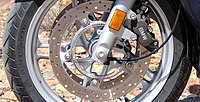
Back Sluitweer-remstelsel Afrikaans نظام منع انغلاق المكابح Arabic Kilidlənməyə qarşı əyləc sistemi Azerbaijani Антиблокираща система Bulgarian Sistema antibloqueig de rodes Catalan سیستمی دژە قفڵبوونی ڕاگرتن (ئیستۆپ) CKB ABS Czech ABS-bremser Danish Antiblockiersystem German Σύστημα αντιμπλοκαρίσματος τροχών Greek


An anti-lock braking system (ABS) is a safety anti-skid braking system used on aircraft and on land vehicles, such as cars, motorcycles, trucks, and buses.[1] ABS operates by preventing the wheels from locking up during braking, thereby maintaining tractive contact with the road surface and allowing the driver to maintain more control over the vehicle.
ABS is an automated system that uses the principles of threshold braking and cadence braking, techniques which were once practiced by skillful drivers before ABS was widespread. ABS operates at a much faster rate and more effectively than most drivers could manage. Although ABS generally offers improved vehicle control and decreases stopping distances on dry and some slippery surfaces, on loose gravel or snow-covered surfaces ABS may significantly increase braking distance, while still improving steering control.[2][3][4] Since ABS was introduced in production vehicles, such systems have become increasingly sophisticated and effective. Modern versions may not only prevent wheel lock under braking, but may also alter the front-to-rear brake bias. This latter function, depending on its specific capabilities and implementation, is known variously as electronic brakeforce distribution, traction control system, emergency brake assist, or electronic stability control (ESC).
- ^ "Toyota Prius c features safety anti-skid braking system (ABS)". Toyota Motor Corporation Australia. Archived from the original on 7 March 2016. Retrieved 7 March 2019.
Prius c is equipped with Toyota's Anti-skid Braking System (ABS).
- ^ "Effectiveness of ABS and Vehicle Stability Control Systems" (PDF). Royal Automobile Club of Victoria. April 2004. Retrieved 2010-12-07.
- ^ Heißing, Bernd (2011), Chassis Handbook, Springer, ISBN 9783834897893, retrieved February 19, 2013
- ^ "Speed With Style", Cycle World, June 1992, ISSN 0011-4286, retrieved February 19, 2013